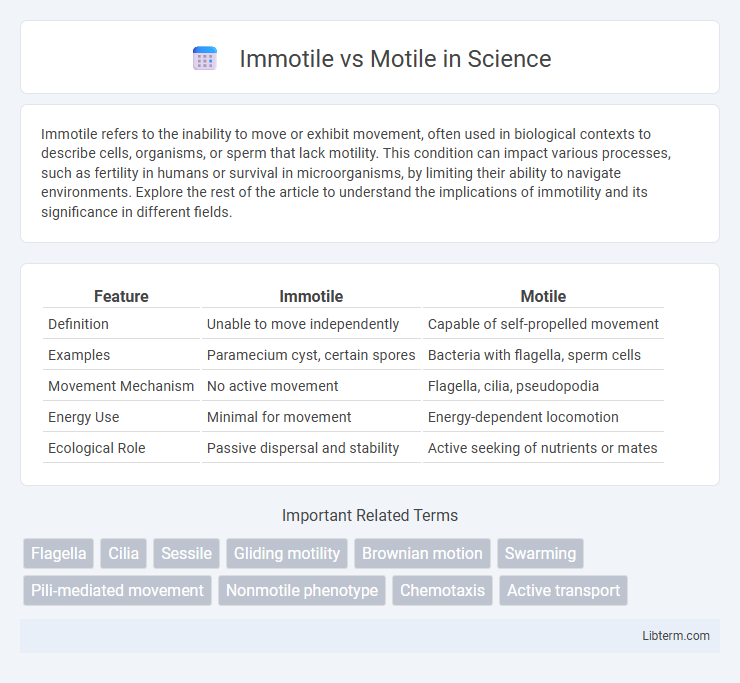Immotile refers to the inability to move or exhibit movement, often used in biological contexts to describe cells, organisms, or sperm that lack motility. This condition can impact various processes, such as fertility in humans or survival in microorganisms, by limiting their ability to navigate environments. Explore the rest of the article to understand the implications of immotility and its significance in different fields.
Table of Comparison
| Feature | Immotile | Motile |
|---|---|---|
| Definition | Unable to move independently | Capable of self-propelled movement |
| Examples | Paramecium cyst, certain spores | Bacteria with flagella, sperm cells |
| Movement Mechanism | No active movement | Flagella, cilia, pseudopodia |
| Energy Use | Minimal for movement | Energy-dependent locomotion |
| Ecological Role | Passive dispersal and stability | Active seeking of nutrients or mates |
Introduction to Immotile and Motile
Immotile cells lack the ability to move independently, often relying on external forces or mechanisms for displacement, common in certain types of bacteria and spermatozoa with structural deficiencies. Motile cells possess specialized structures such as flagella or cilia that enable self-propulsion and directional movement, which is critical for processes like chemotaxis and tissue repair. Understanding the physiological and molecular differences between immotile and motile cells is essential for advancing research in microbiology, reproductive biology, and cellular biomechanics.
Defining Immotility: Key Characteristics
Immotility refers to the inability of cells, organisms, or particles to move independently, characterized by the absence of locomotion mechanisms like flagella, cilia, or pseudopodia. Key characteristics include a reliance on passive transport methods such as diffusion or external forces for displacement and a static position relative to their environment. Understanding immotility is crucial for distinguishing non-motile bacteria, spores, and certain cell types from motile counterparts with active movement abilities.
Defining Motility: Key Characteristics
Motility refers to the ability of organisms or cells to move spontaneously and actively, using metabolic energy. Key characteristics of motile entities include structures like flagella, cilia, or pseudopodia, which facilitate locomotion or directed movement. In contrast, immotile organisms or cells lack these movement structures and remain stationary, relying on external forces for displacement.
Biological Importance of Motile Organisms
Motile organisms, capable of self-propelled movement, play a crucial role in ecosystems by facilitating nutrient cycling, predator-prey interactions, and dispersal of species. Their ability to move enhances survival by enabling access to food, mates, and favorable environmental conditions, which immotile organisms lack. This mobility influences evolutionary processes and ecological balance, making motility a key factor in biological diversity and ecosystem functionality.
Roles of Immotile Organisms in Nature
Immotile organisms, such as plants, fungi, and certain bacteria, play crucial roles in ecosystems by providing structural stability, nutrient cycling, and primary production through photosynthesis. These stationary organisms support food webs by serving as primary producers and decomposers, facilitating energy flow and soil fertility. Their immobility allows them to develop extensive root systems or mycelial networks that enhance nutrient absorption and habitat formation.
Cellular Mechanisms Behind Motility
Cellular motility relies on dynamic cytoskeletal components such as actin filaments and microtubules that enable movement through processes like polymerization and depolymerization. Motor proteins including myosin, dynein, and kinesin convert chemical energy from ATP into mechanical work, driving intracellular transport and cell locomotion. Immotile cells lack the specialized structures or molecular machinery for movement, resulting in static positioning and limited environmental responsiveness.
Evolutionary Perspectives: Immotile vs Motile
Motile organisms possess specialized structures like flagella or cilia, enabling active movement, which has evolved to enhance survival through resource acquisition and predator avoidance. Immotile organisms, lacking such locomotion mechanisms, rely on passive dispersal strategies, often adapting to stable environments where energy conservation outweighs mobility benefits. Evolutionary pressures have thus driven motility as a key trait promoting adaptability and niche expansion, while immotility has favored energy efficiency and environmental specialization.
Examples of Immotile Organisms
Paramecium and Amoeba represent classic examples of motile organisms capable of movement using cilia and pseudopodia, respectively. In contrast, immotile organisms like bread mold (Rhizopus) and yeast (Saccharomyces cerevisiae) lack mechanisms for self-propulsion and rely on external forces for dispersion. These immotile species play essential roles in decomposition and fermentative processes despite their inability to move independently.
Examples of Motile Organisms
Motile organisms exhibit the ability to move independently, often through structures like flagella, cilia, or pseudopodia. Examples of motile organisms include bacteria such as Escherichia coli, protists like Paramecium and Amoeba, and animals ranging from simple sponges to complex vertebrates like fish. These organisms utilize motility for various functions, including seeking food, escaping predators, and reproducing.
Applications and Implications in Science and Medicine
Motile cells, capable of self-propulsion, are crucial in wound healing, immune response, and cancer metastasis, enabling targeted cell migration and tissue regeneration. Immotile cells provide structural integrity and stable environments, essential in maintaining organ function and facilitating specialized cellular roles without movement. Understanding the differences between immotile and motile cells drives advancements in drug delivery, diagnostic imaging, and regenerative medicine by manipulating cell motility for therapeutic outcomes.
Immotile Infographic

 libterm.com
libterm.com